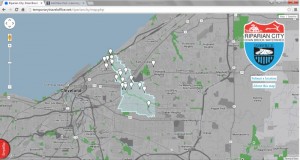For this review, I thought first of the digital, performance, public, etc. projects made by UIUC professor of new media, Ryan Griffis. Ryan uses websites coupled with mini-publications, prints, and other ephemera, as well as performance to question the ways that we define place and interact with the natural world.
When I first started thinking about reviewing Ryan Griffis’ Temporary Travel Office for this assignment, I was hesitant, because, as an artist, I wondered if Ryan’s work would be considered ‘scholarly’ enough for it. But then I began thinking that most artworks are in fact extra-textual scholarly projects. Especially in new media, art projects become sites to interrogate intellectual ideas in a more than textual way, often combining text, digital objects, actual objects, performance and events.
Ryan’s work with the Temporary Travel Office http://temporarytraveloffice.net/ is this kind of project, combining art with ecology, environmentalism, critical geography, archival work, and performance. The project exists as a website, where downloads are available, but also at times as performance or individual ephemeral objects. The Temporary Travel Office is a fictitious travel agency that aids the public by providing materials and tours to often overlooked areas to disrupt the way we define space and how move around in the physical world. Parking lots, forgotten parks, and under privileged neighborhoods become the sites of tourism in Ryan’s imagined travel agency.
While the Temporary Travel Office is involved with multiple projects, publications and tours, one that is especially interesting is the again fictitious Riparian City. Founded in 15,000 BCE, Riparian City is the site of the Doan Watershed in Cleveland. On the Riparian City Website http://temporarytraveloffice.net/ripariancity/ the public can enter information into a map as a way to map locations or even memories to re-imagine the ways that this neighborhood is defined.
Riparian City questions not only who defines geographies, but also what. By creating a Temporary Travel Office in a made up city, Ryan’s work is able to give agency to the space itself, attempting to demonstrate the multitude of forces that shape a sense of place, many that are outside of human control. And, while projects like this originated with performance pieces composed of a physical embassy, with national flags and passports for Riparian citizens, the remnants still exist online, with images of the imagined city and the editable map that citizens who experience a place defined by local space, people, fauna, resources, and climate can still attempt to picture their city, at least digitally.


